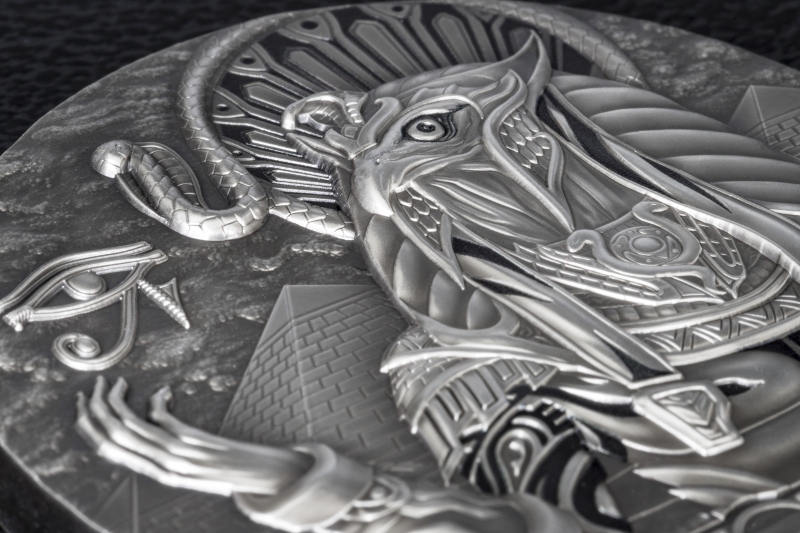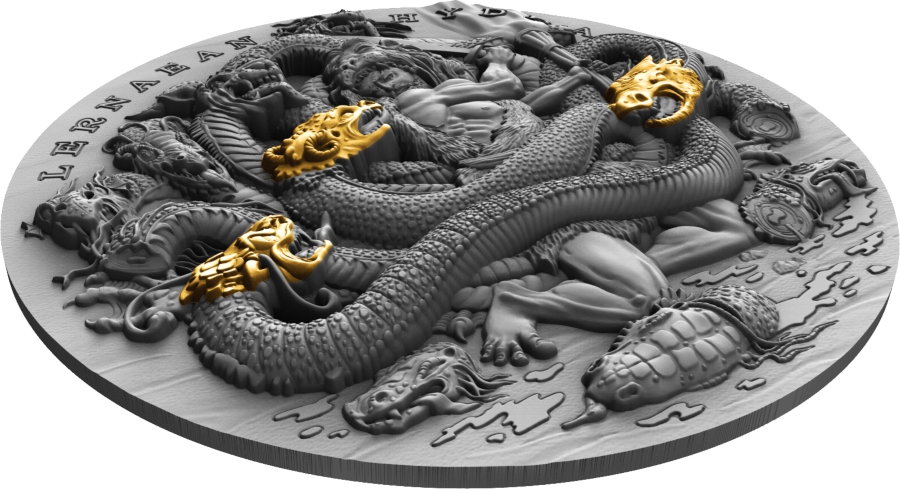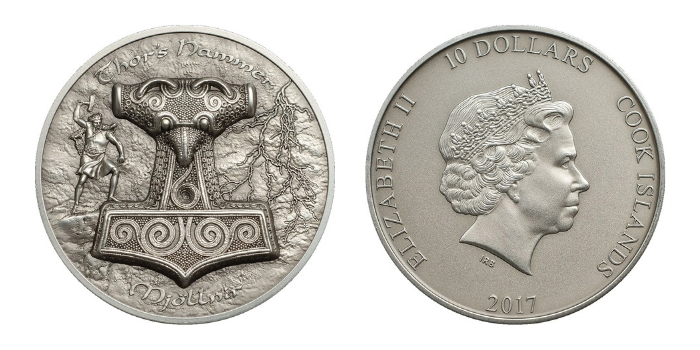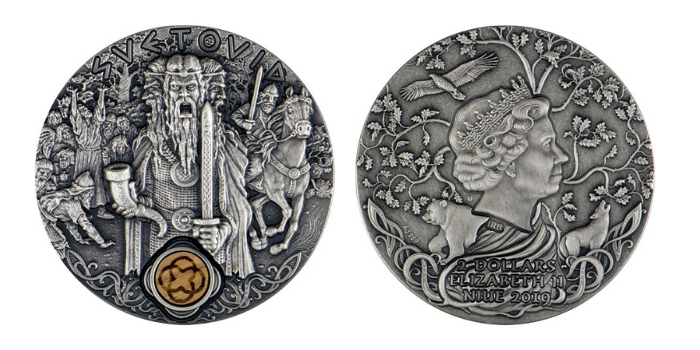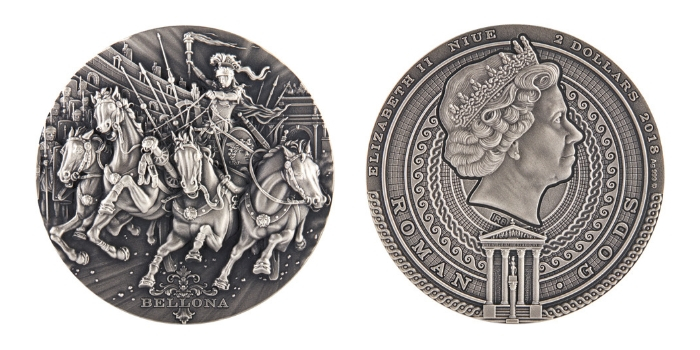5 on Friday - Mithology
5 on Friday
We are starting a new series of entries today. On selected Fridays there will be posts describing 5 selected coins. Each post will contain coins that have something in common, e.g. bullion, accessories, subject, etc. Coins are arranged in random order. We start with the topic "Mythology".
$20 Ra, God of the Sun
In Egyptian mythology it was the god of the Sun, the creator of the world and the master of order in the Universe, the most important of the gods. Most often it was depicted with a solar disk and the head of the falcon. Ancient Egyptians believed that Ra created himself from the Nun Praocean. They also believed that Ra is himself only when he is in the zenith: when he is born of Nut in the morning, he is called Chepri and has the form of a scarab. In the evening, on the other hand, he gets older and turns into an old man, Atuma, who is supported by a staff.
The name of the god was very important for the pharaohs - Rameses is otherwise "son of Ra", which was to give divinity.
Pharaohs were also composed the hymn to the god Ra, the so-called Sunlitany, which was written in the entrance corridors of the royal tombs of the 19th and 20th dynasties in the Valley of Kings.
Ra was the theme of the second coin in the "Gods of the World" series. The coin was struck from 5 ounces of pure silver (93.3 g), subjected to oxidation and decorated with a high relief, thanks to which even small details of the reverse are preserved. The circulation amounted to 333 pieces and sold out completely.
5$ Lernaean Hydra
In Greek mythology it was a monster, a multi-headed water snake. One of the heads of the hydra was immortal. Two new heads grew back in place of the cut off head. The monster had a burrow at the source of the river Amymone, ravaged the area around Lerna. The destruction of Hydra was the second work that Hercules had to do for King Eurydice. Heros lured the hydra out of the burrow with burning arrows, then held his breath and captured it. He tried to cut off the heads of the hydra, but at that time new heads grew on it. Finally, he used the help of his nephew Jolaos, who burned the cut-off heads to prevent the growth of new ones. At the very end, Hercules cut off the immortal head with a sword and buried it under a boulder. In the bile of the killed monster, he immersed the arrowheads, poisoning them and making even their scratches fatal. However, Eurisha did not count this work as completed, because Herakles used Jolaos' help and the hero had to do additional work.
This is the second coin from the series devoted to the "Twelve Labours of Hercules". Two-ounce, oxidised coin with a high relief and selective gold plating. On the reverse side, several heads of the hydra were gilded. On the other hand, each obverse of the series has gilding of the corresponding work of Heros.

10$ Thor's Hammer, Mjöllnir
The most important god in Nordic mythology was Thor. He was considered to be a god of storm and lightning, vital forces and agriculture. He was usually depicted with a long, red beard and Mjöllnir hammer in his hand - a symbol of his strength.
The creation of the hammer is linked to a Nordic legend: one time Loki gave two dwarves, Eitrim and Brokker, the task of creating magnificent weapons that would match the splendour of the Ivaldssen family.
The brothers accepted the challenge and first decided to throw pigskin leather into the smithy. Meanwhile, the Loki tried to disturb them by turning into a fly and biting until he bit Eitri so hard that the other one, bleeding, had to stop working. As a result, the hammer they extracted from the furnace was one-handed, but still perfect. Eitri and Brokkr delivered the hammer to Thor, who has since used it as his main weapon. Not only was the hammer very heavy and strong, its impact also triggered lightning.
Thor's Hammer is the first coin in the "Mythology" series to focus on divine elements in mythologies around the world. This two-ounce oxidized coin was struck from silver. Its craftsmanship is provided by grooves, thanks to which you can admire the detail of the reverse. 999 pieces were minted, we have some last coins left!
2$ Svetovid
In Slavic mythology he was a powerful god (if not the most important), the guardian of war and the patron of abundant crops. He was often said to be omniscient. His attributes are horn and sword, which he used to sow fear among his enemies while wandering the world on his white steed. Within the framework of successful harvests and wars, divination in the name of the Saint was celebrated. Before the war, it was arranged in three rows, driven into the ground, crossed spears and brought a horse dedicated to the deity. If the horse, passing through the spears, stepped over each row with its right foot, the fortune-telling was good for the expeditions. If, however, he had stepped on the left at least once, then the expeditions were cancelled, believing that they would be unsuccessful.
Two ounces of silver of the highest quality, an oxidized finish, a high relief showing the smallest details and an oak insert make this coin an elegant and unique souvenir for all those interested in Slavic history and mythology. This is the second coin in the "Slavic Gods" series. It has a mintage of 500 pieces and we have a few more left.
2$ Bellona
It was the Roman goddess of war, wife (or sister) of Mars. In her temple in the Field of Mars, she received the messages of the countries unfriendly to Rome and the chiefs seeking triumph. In front of the temple, next to the column called "war", there was a war declaration for countries that do not border with Rome. It was also there that the Senate received commanders returning from war expeditions.
The bellona was issued as the second coin in the series "Roman Gods". The coin was struck from 2 ounces of silver. Like Ra, it is oxidized and decorated with a high relief that emphasizes the unique 3D effect. The bellona was struck in 2019 in 500 pieces, which at the moment were sold out in a flash.


